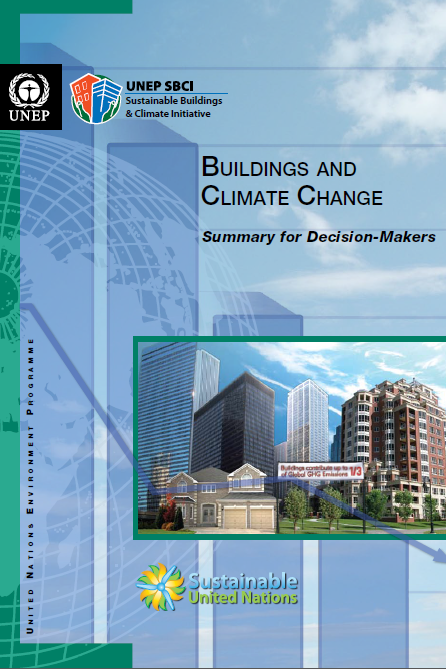
Buildings and Climate Change
Summary for Decision-Makers
Preface
Today, it is widely accepted that human activities are contributing to climate change. The Fourth Assessment Report of the Intergovernmental Panel on Climate Change (IPCC) estimated that between 1970 and 2004, global greenhouse gas emissions due to human activities rose by 70 percent (IPCC, 2007). While the full implications of climate change are not fully understood, scientific evidence suggests that it is a causal factor in rising sea levels, increased occurrence of severe weather events, food shortages, changing patterns of disease, severe water shortages and the loss of tropical forests. Most experts agree that over the next few decades, the world will undergo potentially dangerous changes in climate, which will have a significant impact on almost every aspect of our environment, economies and societies.
It is estimated that at present, buildings contribute as much as one third of total global greenhouse gas emissions, primarily through the use of fossil fuels during their operational phase. Past efforts to address these emissions have had a mixed record of success, although there are many examples which show that carefully considered and properly funded policies can achieve significant reductions. The new international agreement which will be negotiated at Copenhagen in December 2009 provides decision-makers with an unprecedented opportunity to incorporate emissions from buildings into a global strategy on climate change. However, if the desired targets for greenhouse gas emissions reduction are to be met, Decision-Makers have to tackle emissions from the Building Sector with much greater seriousness and vigor than they have to date. They need to make the mitigation of greenhouse gas emissions from buildings the cornerstone of every national climate change strategy.
This Summary for Decision-Makers presents the current state of thinking on how the potential for greenhouse gas emission reductions in buildings can be realized. It has been compiled by the Sustainable Building and Climate Initiative (SBCI), a UNEP-hosted partnership between the UN and public and private stakeholders in the Building Sector, which promotes sustainable building practices globally. One of UNEP-SBCI’s key objectives is to ensure that Parties to the United Nations Framework Convention on Climate Change (UNFCCC) have the information needed to support the mitigation of building-related greenhouse gas emissions. This report is based on research conducted by the UNEP-SBCI under the guidance of its Climate Change Think Tank and in cooperation with the Finnish research institute VTT, the Central European University in Hungary, the Marrakech Task Force of Sustainable Buildings and Construction, and the UNEP Risø Centre on Energy, Climate and Sustainable Development. The results of this research have been published in three reports: Buildings and Climate Change – Status, Challenges and Opportunities (UNEP, 2007a), Assessment of Policy Instruments for Reducing Greenhouse Gas Emissions from Buildings (UNEP, 2007), and The Kyoto Protocol, the Clean Development Mechanism and the Building Sector (UNEP, 2008). UNEP-SBCI will continue to facilitate and support the implementation of these recommendations, and welcomes other stakeholders and interested partners to join it in this endeavor.
Foreword
In forty years we need to have reduced our greenhouse gas emissions by at least 50% to avoid the worst-case scenarios of climate change. In eleven years we need to have achieved at least a 25% reduction in emissions. In three years the current global framework that sets legally binding targets for national emissions, and provides the architecture for global carbon trading – the Kyoto Protocol - will expire. In December 2009 the world’s nations are gathered in Copenhagen to negotiate an agreement on a new global protocol that will enable humanity to achieve the necessary global targets. The challenge is great, but so are the opportunities.
The building sector contributes up to 30% of global annual green house gas emissions and consumes up to 40% of all energy. Given the massive growth in new construction in economies in transition, and the inefficiencies of existing building stock worldwide, if nothing is done, greenhouse gas emissions from buildings will more than double in the next 20 years. Therefore, if targets for greenhouse gas emissions reduction are to be met, it is clear that decision-makers must tackle emissions from the building sector. Mitigation of greenhouse gas emissions from buildings must be a cornerstone of every national climate change strategy.
The world’s governments can successfully tackle climate change by harnessing the capacity of the building sector to significantly reduce GHG Forewordemissions. Doing so can create jobs, save money – and most importantly, shape a built environment that is a net positive environmental influence – not simply a ‘less-bad’ version of what we currently have. Indeed, cost effective emission reductions and energy savings of more than 30% are possible in many countries. Investing in achieving such results in the building sector also has the potential to boost the local economy and improve living conditions, particularly for low-income communities.
This report – Buildings & Climate Change: A Summary for Decision-makers draws together the findings of three years of research by UNEP’s Sustainable Buildings & Climate Initiative (SBCI) and it’s partners. It sets out priority actions that can be taken by policy makers and industry stakeholders locally, regionally and globally to deliver economically beneficial and significant reductions in building-related greenhouse gas emissions.
One of UNEP-SBCI’s key objectives is to ensure that Parties to the United Nations Framework Convention on Climate Change (UNFCCC) have the information needed to support the mitigation of building-related greenhouse gas emissions. SBCI’s Industry stakeholders are already showing leadership and producing results. Buildings & Climate Change: A Summary for Decision-makers presents a strategic approach to harnessing this capacity. The challenge now is for all nations to support their building industries by mainstreaming energy efficient and low-GHG emissions building.
Sylvie Lemmet
Director
Division of Technology, Industry and Economics
UNEP


































